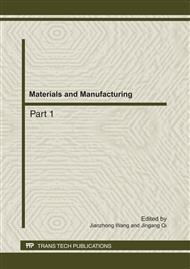p.215
p.220
p.224
p.228
p.233
p.238
p.242
p.246
p.250
Influences of Acting Parameters of Electric Pulse Modification on the Al-22%Si-1.5%Cu Alloy
Abstract:
Hypereutectic Al-Si alloy are desirable and promising for many structural applications. The influences of electric pulse parameters on Al-22%Si-1.5%Cu alloy by using OM (optical microscope) analysis along with wear test had been investigated. This work focused on studying the comparison of its solidification structure and wear resistance property with and without electric pulse treatment, respectively. The results indicated that EPM (electric pulse modification) treatment with different voltage parameters along with the frequency parameters both had the remarkable effects on micro-structure, and the grain size of alloy was refined gradually with the increase of pulse voltage or frequency. The wear resistance property of the alloy was enhanced by electric pulse treatment. It was observed from DSC cooling curve that the precipitation peak point of primary silicon was delayed by electric pulse modification comparing to the original sample without electric pulse treatment, which was analyzed to play a critical key in the alloy grain refinement.
Info:
Periodical:
Pages:
233-237
Citation:
Online since:
July 2011
Authors:
Price:
Сopyright:
© 2011 Trans Tech Publications Ltd. All Rights Reserved
Share:
Citation:


